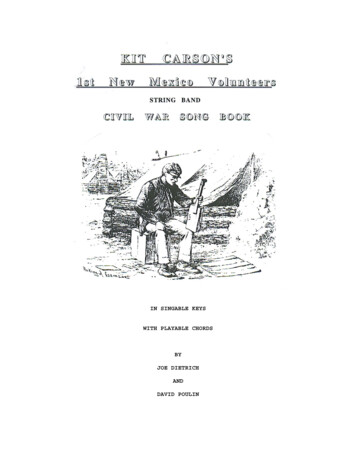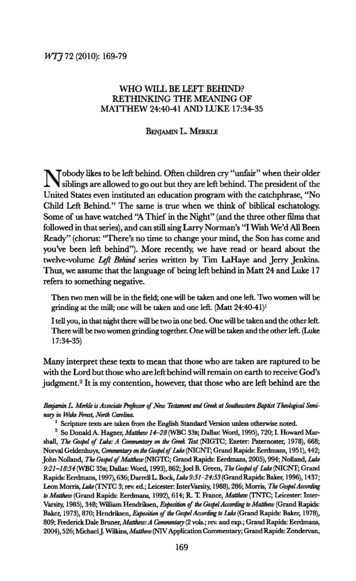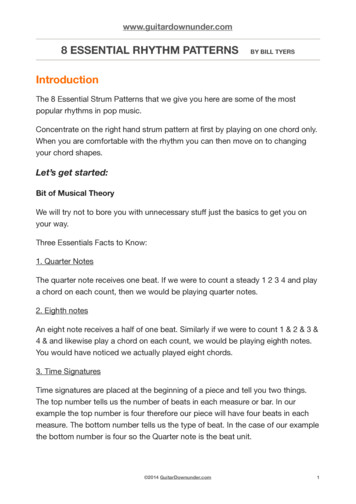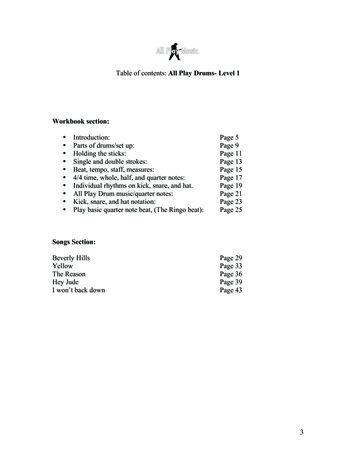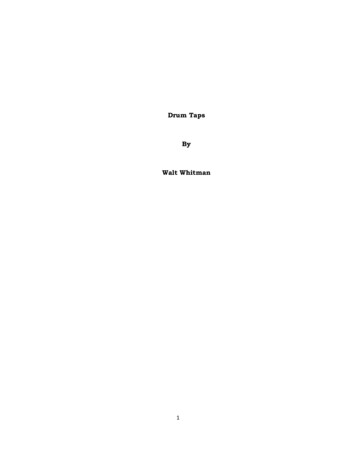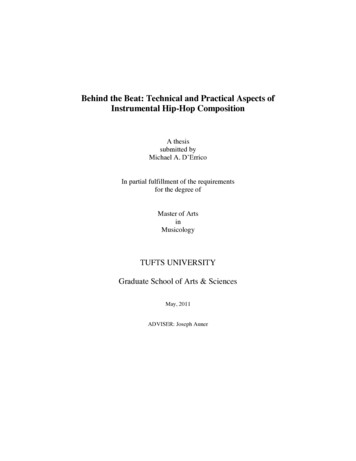
Transcription
Behind the Beat: Technical and Practical Aspects ofInstrumental Hip-Hop CompositionA thesissubmitted byMichael A. D’ErricoIn partial fulfillment of the requirementsfor the degree ofMaster of ArtsinMusicologyTUFTS UNIVERSITYGraduate School of Arts & SciencesMay, 2011ADVISER: Joseph Auner
ABSTRACTFrom DJ Premier’s beat productions in the early ’90s to Kanye West’s liveperformance at the 2010 Video Music Awards, the Akai MPC has long been consideredstandard sampling technology in any hip-hop production studio. Expanding upon thevarious techniques developed by pioneering hip-hop DJs—including beat-juggling,cutting, and mixing—the MPC introduced a much wider range of possibilities regardingnot only the manipulation of individual samples, but their assemblage into a musicalcomposition as well. Furthermore, the expansion of the machine has coincided with themusical development of the hip-hop tradition, as producers have responded and reacted tochanging technological trends with increasingly innovative trends in performancepractice.Through analyses of several tracks by DJ Shadow, Madlib, and Flying Lotus, thispaper will fill a major gap in hip-hop scholarship by exploring both the technical aspectsof the music’s construction as well as how these producers have responded and reacted tothe changing characteristics of the MPC throughout its development. In exposing diversetechnical and musical trends that have received little attention from scholars, this paperhopes to provide a missing link to the way we analyze hip-hop music and culture.
TABLE OF CONTENTSIntroduction: Notes on the “Underground”I. Endtroducing the Akai MPCII. Madlib “The Beat Konducta” and the “Hip-Hop Sublime”III. “Keepin’ it Real”: “Liveness” and the Externalization of the DigitalInterface1193960Conclusion: “Full Circle,” Death and Rebirth in Hip-Hop76Bibliography81Discography85
LIST OF FIGURESFigure 1: Akai MPC 60Figure 2: E-Mu SP-1200Figure 3: Endtroducing album coverFigure 4: “Sequence Mode” screenshot taken from MPC 1000Figure 5: “Song Mode” screenshot taken from MPC 1000Figure 6: “Trim Mode” screenshot taken from MPC 1000Figure 7: Transcription of “Building Steam With a Grain of Salt” (I)Figure 8: “Program Mode” screenshot taken from MPC 1000Figure 9: Transcription of “Building Steam With a Grain of Salt” (II)Figure 10: MPC 4000Figure 11: NPR’s “The Loudness Wars” diagramFigure 12: “Beat Deconstruction” of “The Payback”Figure 13: Transcription of “Dirty Hop (The Shuffle)” (I)Figure 14: Transcription of “Dirty Hop (The Shuffle)” (II)Figure 15: Ableton Live “Session View”Figure 16: Akai MPD 32Figure 17: Ableton Live “Sample WarpFigure 18: Ableton Live Drum RackFigure 19: Akai MPD interface with sample “chops” on padsFigure 20: Ableton Live Audio to MIDI notation 2121232627283030314550525758656869696973
INTRODUCTION: NOTES ON THE “UNDERGROUND”At first glance there are simply dire predictions based on easily arousedprejudices against new technologies. Yet there are also phases ofsettlement in which formerly innovating technologies have been absorbedand only the currently new forms are a threat.1In his headlining performance at the 2010 MTV Video Music Awards, KanyeWest surprised many by a performance of his new song, “Runaway,” which heintroduced by sequencing the musical tracks on an Akai MPC 2000XL sampler/drummachine. Positioned as the literal center of the stage through a minimal set design towhich the TV viewer was introduced a bird’s eye view camera angle, the device stoodnext to Kanye on a small Greek architectural column. After each verse and chorus Westwalked back to the MPC and drummed out some short vocal phrases on the machine’spads, foregrounding the physical, percussive nature of the beatmaking process. Indeed, inthose short moments concluding the award ceremony millions of MTV viewers aroundthe world witnessed, perhaps for the first time, what goes on behind the beat of hip-hop,through the exhibition of a primary form of its production. This almost fetishistic focuson a piece of musical hardware was a far cry from the apology to Taylor Swift that manyexpected of West—after the 2009 incident in which he stormed the stage while Swift wasgiving her acceptance speech—and it also differed sharply from the bombastic drumextravaganza that he gave the audience two years earlier.Initially, the press did not know how to respond. Pitchfork was perhaps the onlymajor music news outlet that attempted to explain the details of the device’s usage, as 1Raymond Williams, Television: Technology and Cultural Form (Hanover and London:Wesleyan University Press, 1974), 133.
they noted, “Kanye made his own beat onstage with a drum machine.”2 It was not untilFebruary of 2011 that the New York Times elaborated on this shallow statement,describing Kanye “playing an MPC 2000XL and triggering a series of piano notes,recorded drum sequences and Rick James vocal samples.”3Yet even as the New York Times provided some much needed fundamental insighton the device, their surface-level description ultimately reflected an etic perspective thatended up implicitly reinforcing the notion of the Akai MPC as a specialized tool for“underground” hip-hop producers. These instrumental beatmakers have established aunique subgenre in hip-hop, asserting their “authenticity” through music technologies andproduction techniques that have stemmed from a distinct musical lineage of producersand DJs of the past, including Grandmaster Flash, the RZA of the Wu-Tang Clan, and JDilla, just to name a few.4 Speaking from this perspective of the hip-hop culture,countless hip-hop blogs and webzines praised Kanye for his use of the MPC, as hip-hopmagazine XXL tweeted about the event, “There is an MPC on the VMA stage. Makes meproud to be a part of hip-hop.” One commenter responded to a video post of theperformance writing, “This is hip-hop at its best. I mean the fool pulled out the MPC androcked the crowd like a true MC would.”5 2Ryan Dombal, “Video: Kanye and Other VMA Highlights,” er-vma-highlights/ (accessed October 17, 2010).3Jon Caramanica, “Lots of Beats, but No Drum in sic/13beatmachine.html (accessed February 16,2011).4Words such as essential, canon, and tradition are introduced with quotation marks so as to avoidessentializing or homogenizing hip-hop as a single, absolute cultural entity. I use themextensively only to acknowledge that many music-making processes in hip-hop have been handeddown explicitly, through oral traditions, as well as implicitly, through technological changes andother historical constructs—as I explain in this thesis.5Adegoke Ademoye, comment on “Kanye West featuring Pusha T: Runaway (2010 MTV VMAPerformance),” Davis Huynh on Hype Beast Blog, comment posted September 13, 2010,
It is understandable why Kanye chose literally to put this mythical gem of hip-hoptechnology on a pedestal for the 2010 VMA performance. The release of his 2008 album808s and Heartbreaks left his more straight-ahead hip-hop fans feeling confused andbetrayed by the perceived overuse of autotune and “inauthentic” digital synthesizers,some fans reacting in disturbingly hateful rants.6 Furthermore, getting mixed up in thegossip of popular media through the incident with Taylor Swift at the 2009 VMAsseemed to further undercut West’s status as an “underground” artist who is true to theorigins of hip-hop. Using the MPC, a device that has long been a secret weapon in thehip-hop producer’s arsenal as well as a marker of “underground” authenticity, served as away to reconcile his current status as a popular artist with his musical roots.7 Yet,Kanye’s performance stands as just one of the ways in which hip-hop producers and DJsuse technology as a means of positioning themselves within an “authentic,” “real” hiphop lineage.While the New York Times article asserts that the key to using the MPC as a livetool is “thinking about it with enough dimension physical dimension, but also technicaldimension a skill that can be enhanced by an understanding of how to tweak what goeson inside the machine,” they—like most writers on hip-hop culture—do not attempt to pusha-t-runaway-2010-mtv-vmaperformance/ (accessed October 17, 2010).6Assertions of “authenticity” and “realness” are just one aspect of the many social meaningsgenerated by technology. Similarly, technology carries many racial, gendered, and classconnotations. As an anonymous user of the RapRadar.com forums wrote, “THIS HOMO NIGGADID HIS THING BUT AUTOTUNE AT THE END WAS AN EPIC FAIL!!!!!” thus positing theuse of technology as a simultaneously masculinizing and emasculating social usha-t-debut-runaway-at-vmas/ (accessed October17, 2010).7In this way it is interesting to note that West dedicated the VMA performance to his mother,thus affirming the event as identifying with a “roots” ma-performance-mother/ (accessed October 17, 2010).
probe these issues.8 The purpose of this study is to expand current understandings of hiphop in academic scholarship by dealing with the technological devices used by DJs andproducers in the compositional processes of beatmaking in “underground” instrumentalhip-hop. In this thesis I will argue that as technologies used to produce hip-hop musicdevelop along with the spread of the culture itself, producers and DJs utilize the newtools as extensions of previous technologies and cultural practices, always attempting toassert perceptibly “authentic” identities in line with specific hip-hop traditions. In lookingat changes in technical design and practice I will reveal not only the ways in which theproduction styles and performance practices in hip-hop expand as a result of theprocesses I will discuss in the next paragraph, but also the ways in which discoursessurrounding the culture have limited our conceptions of the stylistic diversity of hip-hop’smusical history.It is not a goal of this study to impose essentialist claims of authenticity onto asingle branch of instrumental hip-hop. On the contrary, I hope to simply shed light onspecific popular trends and developments that are particularly recognizable at thismoment in the evolution of the music. My use of terms such as “authentic,”“underground,” “real,” and “commercial” should not be interpreted as fixed definitionsand descriptors of actual musical communities but rather fluid terms that change based onthe chronology, geography, and—most significant to my thesis—technology of theindividuals making the assertions. What it means to “keep it real” differs betweencountries, regions, shared communities (physical, cultural, virtual), and historical 8Jon Caramanica, “Lots of Beats, but No Drum in sic/13beatmachine.html (accessed February 16,2011).
traditions of producers and DJs.9 Of course, this does not mean that we should treat theterms arbitrarily, as in Paul Harkins’ shallow description of the term “underground” as “anebulous and problematic term that inhibits a comparative exploration of genres andstyles in favour of a narrow focus on ‘perceived non-mainstream cultural and economicspace.’”10 At a fundamental level, this definition is accurate in pinpointing the epistemicroots of the term, but the negative connotations of the definition deny a discussion of thecomplexities of the term as it is used in an experiential context. By placing the term firstand foremost in the context of how the various producers and DJs I discuss appropriate it,I hope to highlight the contradictory nature of the term while recognizing the intensevalue that musicians place on it, as this sentiment drives much of their creative work.A further qualification is needed for the category “instrumental hip-hop” as well.As I use the term throughout this thesis, it should be recognized fundamentally as adistinct subgenre of hip-hop music that intentionally leaves out the rap element.11 By thisI do not mean instrumental versions of rap songs, but rather beat tapes and mixtapes thatare created specifically as a way of highlighting the technical skill of the producer or DJ.Furthermore, I am locating both of these terms in the context of the hip-hop tradition inwhich terms such as producer (connoting the “studio” beatmaker) and DJ (connoting the“live” beatmaker) become interchangeable. A “producer” is not just the studio engineer 9For an in-depth discussion of the importance of geographical location in the construction of hiphop identities, check out Murray Forman, The ‘Hood Comes First: Race, Space, and Place in Rapand Hip-Hop (Middletown, CT: Wesleyan University Press, 2002).10Paul Harkins, “Microsampling: From Akufen’s Microhouse to Todd Edwards and the Sound ofUK Garage,” in Musical Rhythm in the Age of Digital Reproduction, ed. Anne Danielsen(Burlington, VT: Ashgate, 2010), 178.11Whereas Schloss (2004) views the primary aesthetic binary of hip-hop to occur between “live”and “sampled-based” hip-hop production, I hope to problematize this distinction by introducingspecific trends in “instrumental hip-hop” that allow for the expansion of who and what gets to beconsidered “hip-hop.”
or manager of the recording sessions—as he or she may be in other popular musicstyles—but also the studio beatmaker and the “live” DJ showcasing his or her material.In this context, while it is arguable that the terms are rooted in specific technologies—theDJ being tied to turntable practice and the producer to hardware sampling practice—thespace of the “live” performance immediatizes not only the turntable performance, but thehardware sampler as well. Upon examination of the historical relationship between“liveness” and mediation, Philip Auslander describes these two concepts in terms of “arelation of dependence and imbrication rather than opposition. That the mediated isengrained in the live is apparent in the structure of the English word ‘immediate.’”12Indeed, the audience of a “live” “underground” instrumental hip-hop performanceexpects to come away from the experience with a deeper understanding of studioprocesses of beat construction.In this way, “liveness” is generated through a mediating process in which thetechnology is foregrounded and made “opaque” for the viewer. Ragnhild Brovig-Hanssenhas defined this process of “opaque mediation,” which includes “direct exposure ofediting tools or processing effects, the ‘musical’ use of technological glitches or sideeffects and the obvious deployment of samples.”13 This process naturalizes thetechnology for the audience, literally making the “live” experience more “real.” As PhilipAuslander writes, “live performance thus has become the means by which mediatizedrepresentations are naturalized, according to a simple logic that appeals to our nostalgia 12Philip Auslander, Liveness: Performance in a Mediatized Culture (London and New York:Routledge, 2008), 56.13Ragnhild Brovig-Hanssen, “Opaque Mediation: The Cut-and-Paste Groove in DJ Food’s‘Break’,” in Musical Rhythm in the Age of Digital Reproduction (Burlington, VT: Ashgate,2010), 159.
for what we assumed was the im-mediate.”14 Kanye West’s VMA performance is aperfect example of this process of naturalization through immediatization, studioproducer as “live” DJ.The historical trajectory of instrumental hip-hop begins with solo turntablists suchas Grandmaster Flash and Afrika Bambaataa, who—while they also created music for rapgroups which they were a part of— defined the core aesthetics of hip-hop compositionthrough the creation of solo mixtapes that showcased the technological capabilities of theturntable.15 As sampling technologies developed and became more affordable in the late1980s and early 90s, hip-hop entered what became known as its “golden era,” defined bythe strong relationship between the rapper and the beatmaker. In this context, producerssuch as DJ Premier from Gangstar and Prince Paul from De La Soul used turntablesalongside popular samplers such as the Akai MPC and E-Mu SP-1200 to createinstrumental mixtapes with a specific audio quality (12-bit sample resolution) andperformance practice that continues to define the sound of “underground,” “old-school”hip-hop to this day. In the absence of a rapper, these DJs, beatmakers, and their audiencedeveloped a specific set of values and aesthetics that were shaped by the capabilities andlimitations of turntable and sampling technologies, as well as the user’s ability totranscend these limitations. In this way, “authentic” hip-hop production was from thebeginning defined by what technologies were used, as well as the ability of the producerto expand on these technologies through individual skill and technological manipulation. 14Philip Auslander, Liveness: Performance in a Mediatized Culture, 2nd ed. (New York:Routledge, 2008), 43.15An insightful discussion of the musical practices of early hip-hop culture can be found in DavidToop, Rap Attack 2: African Rap to Global Hip-Hop, 2nd ed. (New York: Serpent’s Tail, 1991).
As I shall discuss, as hip-hop culture expanded into a national culturalphenomenon through the dissemination of recordings, documentary films, and movies,authenticity and “realness” became powerful tools with which to establish one’sindividual identity against the emerging “commercial”—and thus inauthentic and“fake”—cultural trends. Of course, similar to assertions of “authenticity,” what or who isconsidered “commercial” is variable based on chronology and geography. Eachbeatmaker that I discuss creates their work against perceived “commercial” artists of theirtime, who they view as conformist sell-outs. Along with the commercial dissemination ofhip-hop culture through various media outlets, the 1990s witnessed the expansion andgradual democratization of the samplers, drum machines, and sequencers used to makebeats. New technological tools thus led to a strong aesthetic tension in the compositionalprocess of the hip-hop producer; while offering fresh creative possibilities to showcaseindividual style, changing technologies simultaneously threatened to remove the processof composition from its “authentic” roots in turntablism.The body of this study consists of three case studies that focus on specificproducers of instrumental hip-hop, the technologies they employ to make beats, and howtheir utilization of these technologies reshapes and redefines what we come to know of asthe hip-hop tradition. The case studies chart a chronological trajectory with each producerrepresenting important moments in the development of beatmaking technologies as wellas the dissemination of hip-hop culture across geographic boundaries and genrecategories. In addition to providing specific geographic, chronological, and aestheticframeworks for each producer, I will include a technical discussion of specific productiontools favored by the producer combined with musical analyses of how these tools are
used to construct the beat. Together, these elements combine to form an assertion of“authenticity,” and it is from these assertions that we can understand historicalperformance practice in hip-hop on a larger scale.Central to this discussion is my view that technology, geography, chronology, andaesthetics combine to articulate where a particular producer stands in relation to theperceived hip-hop “canon,” in a statement that is very much an assertion of authenticityand identity. For the arbiters of hip-hop authenticity, everything from what type ofturntable, drum machine, or sampler is used, to the type of sounds that are chosen forsampling and the general affect or “feel” of the beat serve to mark one’s style as unique.My central concern is with the ways in which the interfaces and internal designs of thehardware change, and how musicians integrate these technologies into the aesthetic styleof hip-hop by negotiating between emerging technologies, technical practices, andindividual styles, and the essential cultural practices and traditional styles that have beencreated and constructed throughout the history of the music.The first section will deal with DJ Shadow, an LA-based DJ and producer whoemerged from the early ‘90s “golden era” of hip-hop with a series of instrumentalmixtapes that showcased turntable technique as well as an impressive affinity for “cratedigging,” or the ritualistic process of seeking out compositional sources in vinyl recordcollections. As a white, suburban youth making beats just as hip-hop music was reachinginternational recognition, Shadow represented a specific white “commercial” consumerbase in hip-hop culture.16 Yet his advanced turntable skills, utilization of drum loops 16While “objective” data-measuring services such as Soundscan found that the hip-hop consumerbase was approximately seventy percent white from 1996 to 2001, Bakari Kitwana has questionedthis statistic as a hegemonic tool for the erasure of race in public discourse in Why White KidsLove Hip-Hop (New York: Basic Civitas Books, 2005).
from the Ultimate Breaks & Beats vinyl record series, and his use of samples from early80s hip-hop films such as Wildstyle, also marked Shadow as a dedicated member of thehip-hop “underground,” in which knowledge of the tradition as well as individual skillsmark one as authentic, against the “commercial” Other. Focusing on his 1996 album,Endtroducing , my analysis will show how he uses the Akai MPC sampler as anextension of the turntable by utilizing technical and compositional processes that blur thedistinction between the two.The second section will focus on Madlib, an African-American LA-basedproducer who has gained media attention since the new millennium for his collaborationswith underground hip-hop icons J Dilla (Champion Sound) and MF Doom (Madvillainy).As a member of Stones Throw records—a record label that prides itself on musicaldiversity, providing its listeners with obscure knowledge of various musical traditions—Madlib has released a diverse body of work under multiple aliases including Quasimoto,Yesterday’s New Quintet, Sound Directions, Young Jazz Rebels, as well as a jazz triounder his real name, The Otis Jackson Jr. Trio. My analysis will focus on the work ofperhaps his most popular alias, The Beat Konducta, observing the ways in which Madlibuses a newer model of the MPC—the MPC 4000—to expand processes of samplemanipulation and sequencing possibilities. I will expand on Adam Krims’s notion of the“hip-hop sublime” to include not only the ways in which dense combinations of musicallayers create conflicts in the realm of pitch and timbre, but rhythm as well.17 Thediscussion will thus focus on the ways in which advances in the technology itself allow 17The “Hip-Hop Sublime” was first introduced by Adam Krims at a 1996 interest panel onMarxism at the 1996 annual conference of the American Musicological Society. It was furtherdeveloped in his book, Rap Music and the Poetics of Identity (New York: Cambridge UniversityPress, 2000) as well as the essay “The Hip-Hop Sublime as a Form of Commodification” in thecollection, Music and Marx: Ideas, Practice, Politics (New York and London: Routledge, 2002).
for complex microrhythmic sequencing and digital signal processing that highlight theperformative nature of sampling and sequencing. My notations hope to provide the hiphop scholar with new analytical tools rooted in the compositional processes utilized bythe producers and DJs themselves, as well as shed insight on the manner in whichproducers and DJs assert “authentic” identities in the absence of the turntable.For Madlib, an “authentic” hip-hop identity is aligned with an “authentic” blackidentity through the use of samples from blaxploitation films, jazz, and funk music of the1970s. Sample sources are particularly important in asserting “authentic” identitiesthrough technologies of sonic reproduction, as Tricia Rose writes of the process, “itaffirms black musical history and locates these ‘past’ sounds in the ‘present’ these soulartists have been placed in the foreground of black collective memory.”18 Madlib’s closerelationship with Black music of the past thus offers a historically circular view of theways in which specifically African-American identities are performed in hip-hop music.Rose’s idea of co-performance is particularly important here, as the “performativeresonances” that result from the process of sampling highlight the aural continuity thatexists between the sampled musician and the hip-hop producer.19The final section of the thesis will examine the work of Flying Lotus, an AfricanAmerican, LA-based producer who founded the Brainfeeder musicians collective in2008. The artists on this record label—Daedelus, Teebs, Ras G, and Nosaj Thing, toname a few—come from diverse backgrounds of electronic dance music while remainingrooted in the downtempo, bass-heavy aesthetics of the hip-hop tradition. While theycontinue to make beats for rappers, this group of young producers has emerged in recent 18Tricia Rose, Black Noise: Rap Music and Black Culture in Contemporary America (Hanover,NH: Wesleyan University Press, 1994), 89.19Ibid, 78.
months as international electronic music pioneers making instrumental hip-hop with anew set of technological tools and methods. Flying Lotus in particular has, as I willdiscuss, utilized the Monome, a grid-based MIDI and OSC controller, as well as the AkaiMPD, both as extensions of sample-chopping technologies first introduced by the MPC.Contrary to the “analog” aesthetics of many traditional hip-hop producers, many of theseproducers have integrated laptops into their setup, running new tracker-based DAWs suchas Ableton Live as an integrated workstation with their hardware controllers. While theiruse of various technical devices—as well as their diverse dance music influences—hasmade it hard to pin them down and categorize them as strictly “hip-hop,” their technicalskill, understanding of sample manipulation, and well-integrated live sets have introduceda fresh approach to hip-hop production that expands on the work of previous producersthrough evolving technical practices, thus reinventing “authentic” traditions in thecontext of digital software previously perceived as “inauthentic.”As I noted previously, this is not the first attempt at explaining the compositionalprocesses of hip-hop producers. However, much of the previous scholarship surroundingbeatmaking in hip-hop culture tends to deal primarily with music analytical andsociological concerns. In her definitive sociohistoriography of hip-hop, Black Noise: RapMusic and Black Culture in Contemporary America, Tricia Rose defines the largercultural implications of the “break” and “cut” in the hip-hop style as they pertain toengineering methods in the studio.20 In his essay “Rhythm, Rhyme, and Rhetoric in theMusic of Public Enemy,” Rob Walser uses musical analysis and Western notation to 20 Ibid.
explain how Public Enemy layers samples to create a hip-hop composition.21 While thesekey texts helped to define and legitimize the study of hip-hop in musicological andethnomusicological scholarship, they naturally tended toward a defensive rhetoric thenneeded in order to justify their research, and thus avoided specific details of technicalpractice as it relates to cultural practice.In Rap Music and the Poetics of Identity, Adam Krims attempts to reconcilegeneral hermeneutic concerns with the specific analysis of hip-hop songs, detailing athorough genre system for rap music as well as a method of notation known as the“layering graph.”22 Like Walser, this research method is a further attempt to bring thecompositional process of hip-hop into the realm of traditional Western analysis, as theissues he addresses relating to his notational method deal with traditional aspects ofmusic analysis, mainly form and pitch. In this context his system works quite well, as itnotates the complexities of sample juxtaposition and the resulting tonal dissonance.However, in my discussion of Madlib I will expand upon his analysis to include thedifficulties of notating what I will call rhythmic dissonance.While the previous texts have come from musicological and sociologicalperspectives, Joseph G. Schloss’s Making Beats: The Art of Sample-Based Hip-Hop is aseminal ethnographic approach to hip-hop production.23 This text still stands as the mostcomprehensive ethnography of hip-hop beatmaking, dealing with many core aestheticissues in the music including sampling ethics, vinyl collecting, as well as issues of 21Robert Walser, “Rhythm, Rhyme, and Rhetoric in the Music of Public Enemy,”Ethnomusicology 39.2 (1995): 193-217.22Adam Krims, Rap Music and the Poetics of Identity (New York: Cambridge University Press,2000).23Joseph G. Schloss, Making Beats: The Art of Sample-Based Hip-Hop (Middletown, CT:Wesleyan University Press, 2004).
compositional “authenticity.” Notational concerns are voiced, although briefly, Schlossdealing with them in
Sep 13, 2010 · unique subgenre in hip-hop, asserting their “authenticity” through music technologies and production techniques that have stemmed from a distinct musical lineage of producers and DJs of the past, including Grandmaster Flash, the RZA of the Wu-Tang Clan, and J Dilla, just to name a few

